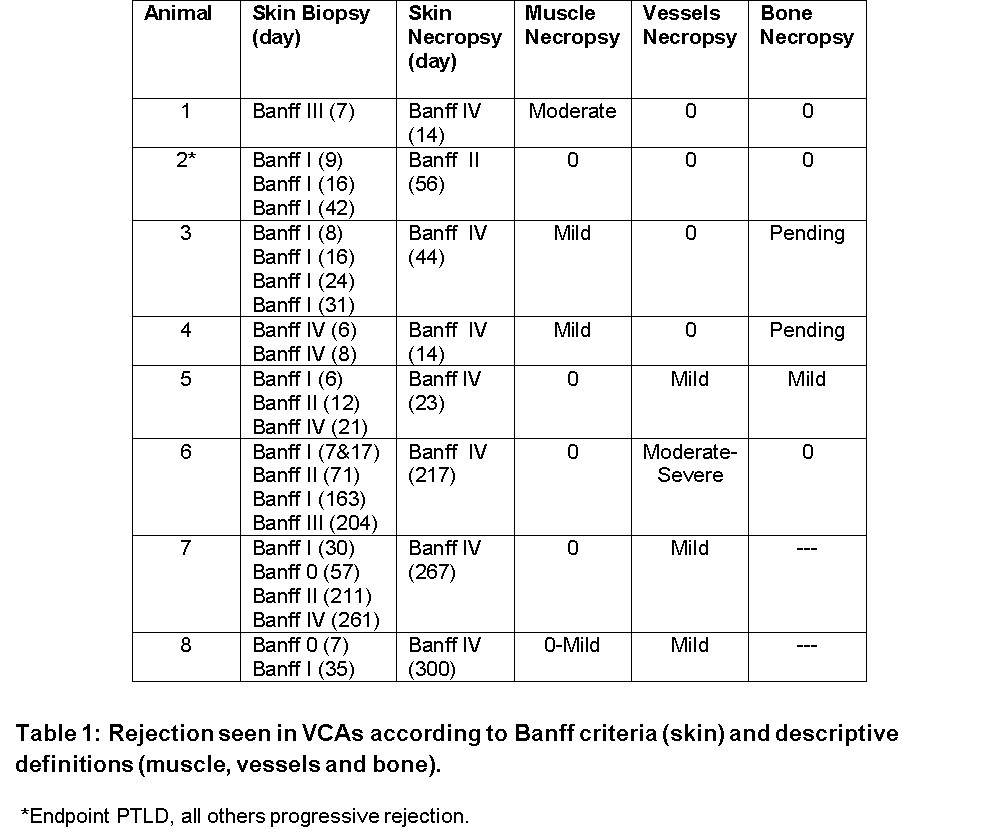Preservation of Musculoskeletal Components in Vascularized Composite Allograft Skin Rejection.
University of Maryland School of Medicine, Baltimore, MD
Meeting: 2017 American Transplant Congress
Abstract number: B298
Keywords: Graft acceptance, Primates, Rejection, Tolerance
Session Information
Session Time: 6:00pm-7:00pm
 Presentation Time: 6:00pm-7:00pm
Presentation Time: 6:00pm-7:00pm
Location: Hall D1
Background: Severe or chronic rejection of vascularized composite allografts (VCA) has resulted in graft loss and patient deaths. 'Split tolerance' has been defined in patterns of skin rejection with preserved muscle and other tissue components. We investigated experiments in our established non-human primate VCA model to determine the status of musculoskeletal components during skin rejection.
Methods: Skin and deep tissue from facial VCA in MHC mismatched cynomolgus macaques were evaluated for rejection (n=8). Immunosuppression consisting of tacrolimus and mycophenolate mofetil was used in each of these VCA experiments. Histologic specimens of skin, muscle, bone, and vessels were reviewed by transplant pathologists and rejection was graded according to Banff criteria or descriptive definitions.
Results: Endpoint in 7 experiments was severe Banff IV skin rejection with one reaching endpoint from malignancy (Table 1). Only mild to moderate inflammation in the subcutaneous tissue was observed. Muscle histology at endpoint demonstrated either no (n=4), mild (n=3) or moderate (n=1) inflammation. Evaluated bone specimens demonstrated viable osteoblasts with either no (n=3) or mild (n=1) inflammation. Vessel histology at endpoint demonstrated no inflammation (n=4), mild inflammation (n=3), and moderate to severe inflammation (n=1). Conclusions: Face transplantation with chronic immunosuppression in a preclinical model demonstrated skin rejection and loss, while deeper tissue components were uninvolved or with only mild-moderate rejection. These findings support that musculoskeletal components of VCA may be preserved after skin rejection. Salvage strategies for VCA skin rejection should be developed to take advantage of the preservation of VCA musculoskeletal components.
Conclusions: Face transplantation with chronic immunosuppression in a preclinical model demonstrated skin rejection and loss, while deeper tissue components were uninvolved or with only mild-moderate rejection. These findings support that musculoskeletal components of VCA may be preserved after skin rejection. Salvage strategies for VCA skin rejection should be developed to take advantage of the preservation of VCA musculoskeletal components.
CITATION INFORMATION: Buckingham E, Khalifeh A, Uluer M, Hassenein W, Drachenberg C, Nam A, Twaddell W, Bartlett S, Barth R. Preservation of Musculoskeletal Components in Vascularized Composite Allograft Skin Rejection. Am J Transplant. 2017;17 (suppl 3).
To cite this abstract in AMA style:
Buckingham E, Khalifeh A, Uluer M, Hassenein W, Drachenberg C, Nam A, Twaddell W, Bartlett S, Barth R. Preservation of Musculoskeletal Components in Vascularized Composite Allograft Skin Rejection. [abstract]. Am J Transplant. 2017; 17 (suppl 3). https://atcmeetingabstracts.com/abstract/preservation-of-musculoskeletal-components-in-vascularized-composite-allograft-skin-rejection/. Accessed January 1, 2026.« Back to 2017 American Transplant Congress
